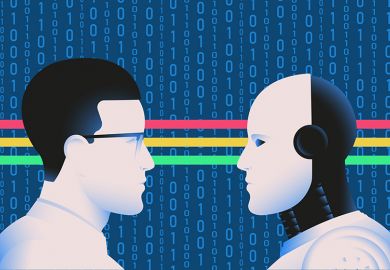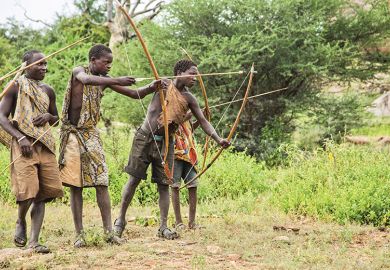As a globally circulating sign, the Yanomami, a group of Amazonian Indians resident in southern Venezuela and northern Brazil, play a similar role in the present age to that played by Tahitians in the late 18th century. For Denis Diderot, the Tahitians were a utopian foil to be played against a corrupt and culturally mistaken Europe. In Supplement to Bougainville's Voyage (1773), imaginary Tahitians are variously presented as guardians of the only "true morality" and as calculating exploiters of naive Europeans.
In a similar way, the Yanomami have appeared on the stage of Euro-American ideological debates as exemplifications of the sociobiological adaptive benefits of violence (in Napoleon Chagnon's work) and as embodiments of a noble gentleness (in the work of Jacques Lizot).
But of course the Yanomami exist beyond the sign: unlike Diderot, who only ever invoked authority in his description playfully, for the participants in the Yanomami controversy plausibility is everything. One is put in mind of the debate between Las Casas and Oviedo in Valladolid in 1550.
Autopticism (eyewitnessing) circles in ever larger arcs, its claims ultimately being settled on the basis of an ethics and politics imported from outside the evidence.
The "fierce controversy" to which the subtitle of Robert Borofsky's engrossing and important book alludes was generated by accusations made by Patrick Tierney, an investigative journalist. Directed against geneticist James Neel and anthropologist Chagnon, who had both conducted research among the Yanomami, Tierney described unethical behaviour "that at times bordered on the criminal". In his book, Darkness in El Dorado , Tierney probed the way the Yanomami "have been used to fulfil fantasies, scientific paradigms and preconceptions". Specifically, he accused Neel of exacerbating a measles epidemic during a field trip in 1968. Chagnon stood accused of many things: exaggerating violence as a dynamic of Yanomami society, provoking much of the warfare he claimed to document in stage-managed ethnographic documentaries, fabricating data and violating Venezuelan law in the promotion of a private Yanomami reserve. CNN.com described Tierney's book as "an explosive account of how... self-serving anthropologists and obsessed scientists placed one of the Amazon basin's oldest tribes on the cusp of extinction".
In a book that is directed at anthropologists and focuses on the shortcomings of protocols of the American Anthropological Association (AAA), it is Chagnon who takes centre stage. The impact of his sociobiologically motivated work was remarkable - the 3 million copies sold of various editions of Y?nomamö: The Fierce People make it the biggest selling ethnography in the postwar period. Borofsky presumes that most anthropologists have read it. For anthropologists, the Yanomami have inhabited a foundational and comparative space alongside Trobriand Islanders and the Nuer - "shared points of reference for the discipline in these fragmented times".
The book, avowedly presented as an undergraduate teaching aid and a call to anthropological student activism and "disciplinary change", gives formal structure to its ideological aims: it is well laid out and ultra-clear in its intentions. Everything is signposted, summarised in overviews and repeatedly inscribed in pursuit of clarity and ethicality. The first half of the book summarises information available elsewhere, and the lengthy second half presents a series of round-table discussions that offer new arguments and perspectives from engaged academics such as Terry Turner.
The book's subtitle asks "what we can learn" from the controversy, and Borofsky foregrounds the importance of the student-dominated responses to the AAA. So far so good - it is a necessary optimism to believe that the next generation will invent a more just world. But Borofsky's in many ways laudable project becomes one of professional redemption rather than a political struggle for a better world. So intimately engaged is it with the failures of the AAA's bureaucratic protocols that the project itself becomes partially subsumed by a concern with proceduralism that seems unwittingly to displace the more revolutionary pedagogy that lies within this story.
As Theodor Adorno might have phrased it, a more expansive politics becomes a mere "matter of evaluation". That more radical exploration would involve more than a consideration of whether colleagues should be disciplined more swiftly for breaching AAA ethical guidelines, and the potential benefits of assigning royalties from academic works to the communities they describe (Borofsky's royalties are so assigned - Chagnon's reportedly $1 million (£579,000 million) royalties were not). Such an examination would ask more fundamental questions about the responsibilities of intellectuals who are citizens of nations prosecuting an illegal war and murdering tens of thousands of civilians in the name of freedom. Whether Neel did, or did not, do enough to assist with the 1968 measles epidemic is an important question, but if it becomes the main issue, at the expense of the criminal political activities of our current masters, it becomes a refuge from, rather than a provocation to, the kind of political transformation Borofsky rightly desires.
Christopher Pinney is professor of anthropology and visual culture, University College London.
Yanomami: The Fierce Controversy and What We Can Learn From It
Author - Robert Borofsky
Publisher - University of California Press
Pages - 372
Price - £32.50 and £12.95
ISBN - 0 520 24403 6 and 24404 4
Register to continue
Why register?
- Registration is free and only takes a moment
- Once registered, you can read 3 articles a month
- Sign up for our newsletter
Subscribe
Or subscribe for unlimited access to:
- Unlimited access to news, views, insights & reviews
- Digital editions
- Digital access to THE’s university and college rankings analysis
Already registered or a current subscriber?



